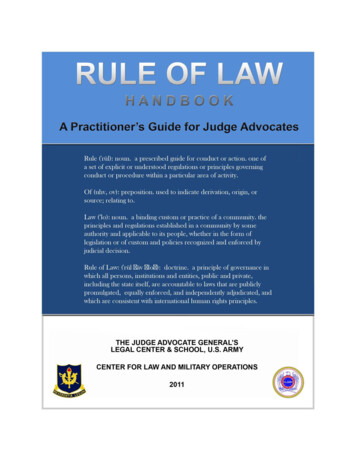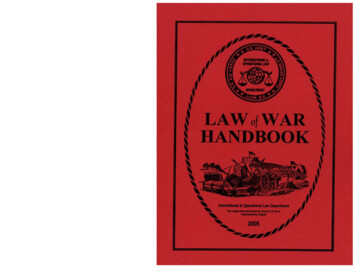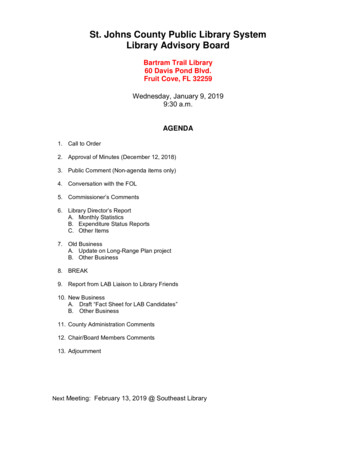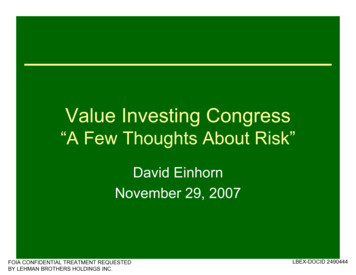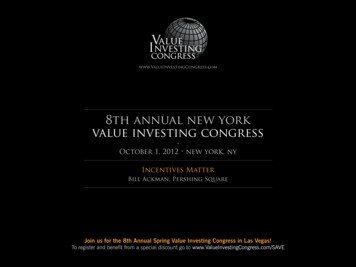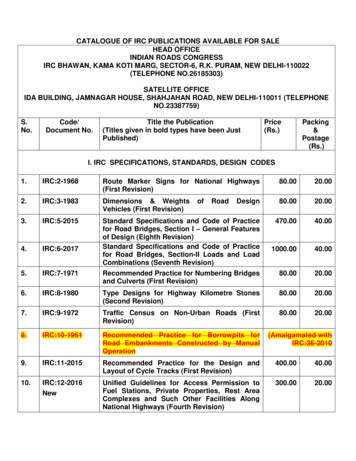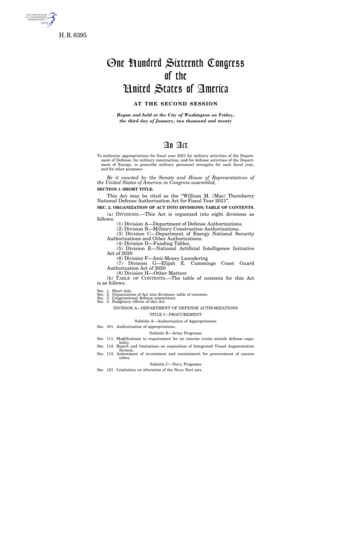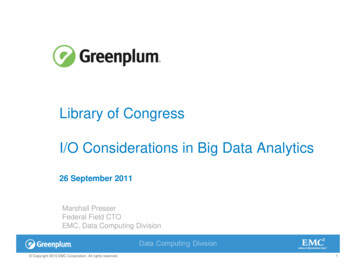
Transcription
Library of CongressI/O Considerations in Big Data Analytics26 September 2011Marshall PresserFederal Field CTOEMC, Data Computing Division Copyright 2010 EMC Corporation. All rights reserved.1
Paradigms in Big DataStructured (relational) dataVery Large Databases (100’s TB )SQL is the access methodCan be monolithic or distributed/parallelVendors distribute software only or applianceUnstructured (non-relational data)Hadoop Clusters (100’s nodes)Map/Reduce is the access methodVendors distribute software only (mostly) Copyright 2010 EMC Corporation. All rights reserved.2
Obstacles in Big DataBoth Relational and Non Relational Approachesmust deal with I/O issues: Latency Bandwidth Data movement in/out of cluster Backup/Recovery High Availability Copyright 2010 EMC Corporation. All rights reserved.3
MPP (Massively Parallel Processing)Shared-Nothing Architecture MPP has extreme scalabilityon general purpose systems Provides automaticparallelization– Just load and query likeany database– Map/Reduce jobs run inparallel All nodes can scan andprocess in parallel– Extremely scalable and I/Ooptimized Linear scalability by addingnodes– Each adds storage, query,processing and loadingperformance Copyright 2010 EMC Corporation. All rights reserved.SQLMapReduceMasterServers.Query planning &dispatchNetworkInterconnectSegmentServers.Query processing &data storageExternalSourcesLoading, streaming,etc.4
Software and Appliances in RelationalBig DataGreenplum DCA – EMC (software and appliance)Neteeza Twin Fin – IBM (appliance only)Teradata 2580 – Teradata ( appliance only)Vertica – HP (software and appliance)All above use distributed data with conventional I/ONeteeza and Teradata virtual proprietary network s/wExadata – Oracle (appliance only)Oracle is the only vendor with a shared disk modelUses Infiniband to solve latency and bandwidth issues Copyright 2010 EMC Corporation. All rights reserved.5
Backing up to from an Appliance Requirements: Parallel backup from allnodes, not just the master Incremental or dedupability via NFS shares orsimilar Conneted to privatenetwork, not public Copyright 2010 EMC Corporation. All rights reserved.6
MPP Database Resilience Relies onIn-Cluster Mirroring Logic Cluster comprises– Master servers– Multiple Segment servers Segment servers supportmultiple database instances– Active primary instances– Standby mirror instances 1:1 mapping between Primaryand Mirror instances Synchronous mirroring Copyright 2010 EMC Corporation. All rights reserved.Set of Active SegmentInstances7
SAN Mirror Configuration:Mirrors Placed on SAN StorageSegmentServer 1P1P2P3M6M8M10SegmentServer 2P4P5P6M1M9M11SANSegmentServer 3P7P8P9M2M4M12SegmentServer 4P10P11P12M3M5M7Doesn’t this violate principle of all local storage? Maybe, maybe not. Copyright 2010 EMC Corporation. All rights reserved.8
One Example: SAN Mirror to VMAX SAN Default DCA configuration hasSegment Primaries and SegmentMirrors on internal storage SAN Mirror offloads SegmentMirrors to VMAX SAN storageP1M1 P96 Copyright 2010 EMC Corporation. All rights reserved.M96––––Doubles effective capacity of a DCAFoundation of SAN leverageSeamless off-host backupsData replication No performance impact– Primaries on internal storage– SAN sized for load and failedsegment server9
One Example: SAN Mirror –With SANbased replication for mDCASRDFNo consumption of serverbased resources to performdistance copiesP1M1/R1SAN MirrorWANorSANSynchronous orAsynchronousM1/R2Database on SANPerformed by SRDF / V-MAX Copyright 2010 EMC Corporation. All rights reserved.10
What is Hadoop?Three major components An infrastructure for running Map/Reduce jobs– Mappers produce name/value pairs– Reducers aggregate Mapper Output HDFS - A distributed file system for holding input data, outputdata, and intermediate result An ecosystem of higher level tools overlaid on MapReduceand thers Copyright 2010 EMC Corporation. All rights reserved.11
Why Hadoop? With massive growth of unstructured data Hadoop hasquickly become an important new data platformand technology– We’ve seen this first-hand with customers deploying Hadoopalongside relational databases A large number of major business/government agencyare evaluating Hadoop or have Hadoop in production Over 22 organizations running 1 PB Hadoop Clusters Average Hadoop cluster is 30 nodes and growing. Copyright 2010 EMC Corporation. All rights reserved.12
Why Not Hadoop?Hadoop still a “roll your own” technologyAppliances just appearing Sep/Oct 2011 Wide scale acceptance requires– Better HA features– More performant I/O– Ease of use and management Access to HDFS through a single Name Node– Single point of failure– Possible contention in large clusters– All Name Node data held in memory, limiting number of files in cluster Unlike SQL, programming model via Hadoop API a rare skill Apache distribution written in Java, good for portability, less goodfor speed of execution Copyright 2010 EMC Corporation. All rights reserved.13
Storage Layer Improvements to ApacheHadoop Distribution HDFS optimizations– Recoded in C, not Java, different I/O philosophy– Completely API compatible NFS interface for data movement in/out of HDFS Distributed Name Node eliminates SPOF for NameNode Remote Mirroring and Snapshots for HA Multiple readers/writers – lockless storage Built-in transparent compression/encryption Copyright 2010 EMC Corporation. All rights reserved.14
Thank youMarshall Presser 240.401.1750 – cell marshall.presser@emc.com Copyright 2010 EMC Corporation. All rights reserved.15
Big Data. Greenplum DCA – EMC (software and appliance) Neteeza Twin Fin – IBM (appliance only) Teradata 2580 – Teradata ( appliance only) Vertica – HP (software and appliance) All above use distributed data with conventional I
